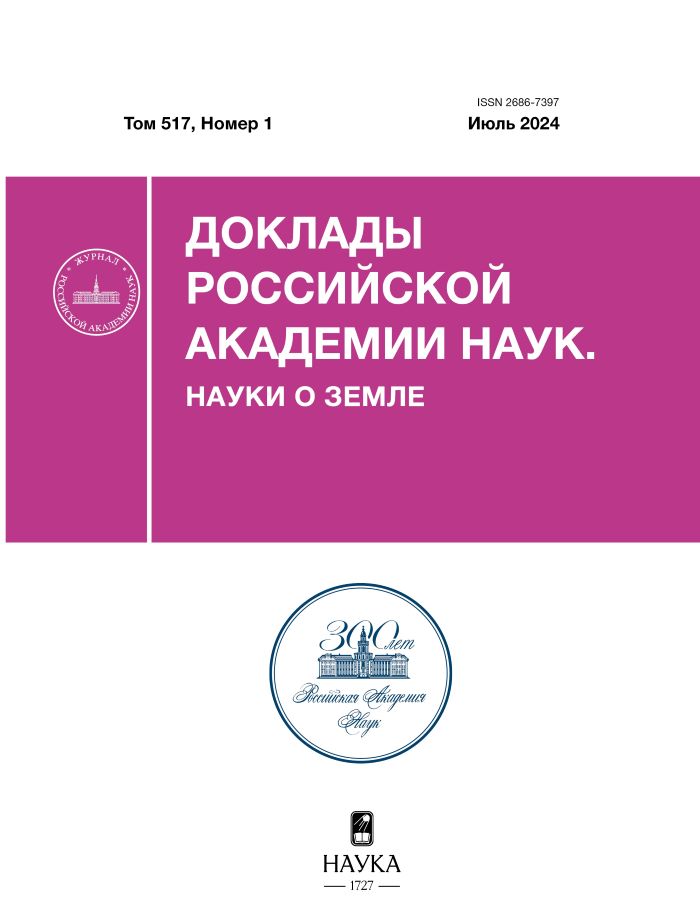The environment of forming of Lower Carboniferous volcanogenic-terrigenous strata of the eastern slope of the Middle and Northern Urals
- 作者: Petrov G.A.1, Maslov A.V.1
-
隶属关系:
- Zavaritsky Institute of Geology and Geochemistry, Ural Branch of Russian Academy of Sciences
- 期: 卷 517, 编号 1 (2024)
- 页面: 27-36
- 栏目: GEOLOGY
- ##submission.dateSubmitted##: 31.01.2025
- ##submission.datePublished##: 13.12.2024
- URL: https://edgccjournal.org/2686-7397/article/view/649999
- DOI: https://doi.org/10.31857/S2686739724070043
- ID: 649999
如何引用文章
详细
The Lower Сarboniferous volcanogenic-terrigenous strata on the eastern slope of the Middle and Northern Urals have been studied. It is shown that these formations are confined to the zones of regional strikeslips and were formed in the conditions of transtension. The geochemical parameters of volcanites show similarities with igneous rocks of both suprasubduction and intraplate environments, which does not contradict the ideas about their formation in the rear of the active continental margin.
全文:
作者简介
G. Petrov
Zavaritsky Institute of Geology and Geochemistry, Ural Branch of Russian Academy of Sciences
编辑信件的主要联系方式.
Email: Georg_Petrov@mail.ru
俄罗斯联邦, Yekaterinburg
A. Maslov
Zavaritsky Institute of Geology and Geochemistry, Ural Branch of Russian Academy of Sciences
Email: Georg_Petrov@mail.ru
Corresponding Member of the RAS
俄罗斯联邦, Yekaterinburg参考
- Государственная геологическая карта Российской Федерации. Масштаб 1:1 000 000 (третье поколение). Cерия Уральская. Лист Р-41 – Ивдель. Объяснительная записка. СПб.: Картфабрика ВСЕГЕИ, 2007. 318 с.
- Государственная геологическая карта Российской Федерации. Масштаб 1:1 000 000 (третье поколение). Cерия Уральская. Лист О-41 – Екатеринбург. Объяснительная записка. СПб.: Картфабрика ВСЕГЕИ, 2011. 492 с.
- Гребенников А. В., Ханчук А. И. Геодинамика и магматизм трансформных окраин Тихоокеанского типа: основные теоретические аспекты и дискриминантные диаграммы // Тихоокеанская геология. 2021. Т. 40. № 1. С. 3–24.
- Жданов А. В. Легенда Уральской серии листов Госгеолкарты-1000/3 (актуализированная версия). СПб.: ВСЕГЕИ, 2009. 380 с.
- Зоненшайн Л. П., Кузьмин М. И., Натапов Л. М. Тектоника литосферных плит территории СССР. Кн. 1. М.: Недра, 1990. 328 с.
- Казаков И .И., Стороженко Е. В., Харитонов И. Н., Стефановский В. В. Государственная геологическая карта Российской Федерации масштаба 1 : 200 000 (издание второе). Серия Средне-Уральская. Лист O-41-XXVI (Асбест). Объяснительная записка. СПб.: Картфабрика ВСЕГЕИ, 2017. 284 с.
- Петров Г. А., Свяжина И. А. Корреляция ордовикско-девонских событий на Уральской и Скандинавской окраинах Балтики: геологические и палеомагнитные данные // Литосфера. 2006. № 4. С. 23–39.
- Петров Г. А. Раннекаменноугольные палеобассейны на восточном склоне Среднего Урала: постановка проблемы интерпретации обстановки формирования и главные черты минерагении // Ежегодник-2009. Екатеринбург: ИГГ УрО РАН, 2010. С. 79–82.
- Петров Г. А., Маслов А. В. Сосьвинско-Лозьвинский грабен – структура растяжения в тылу активной континентальной окраины на восточном склоне Северного Урала // Докл. РАН. Науки о Земле. 2023. Т. 511. № 1. С. 12–18.
- Пучков В. Н. Палеогеодинамика Южного и Среднего Урала. Уфа: Гилем, 2000. 145 с.
- Свяжина И. А., Петров Г. А., Слободчиков Е. А. Палеомагнетизм, тектоника и геодинамика палеозоя среднеуральского фрагмента Восточно-Уральской мегазоны // Литосфера. 2008. № 4. С. 22–34.
- Тевелев А. В., Дегтярев К. Е., Тихомиров П. Л., Кошелева И. А., Косарев А. М., Мосейчук В. М., Правикова Н. В., Сурин Т. Н. Геодинамические обстановки формирования каменноугольных вулканических комплексов Южного Урала и Зауралья // Очерки по региональной тектонике. Т. 1. Южный Урал. М.: Наука, 2005. С. 213–247.
- Филатова Н. И. Специфика магматизма окраинно-континентальных и окраинно-морских бассейнов синсдвиговой природы, западная периферия Тихого океана // Петрология. 2008. Т. 16. № 5. С. 480–500.
- Фролова Т. И., Бурикова И. А. Магматические формации современных геодинамических обстановок. М.: Изд-во МГУ, 1997. 320 с.
- Южаков И. Г., Останин С. Ю., Генералов В. И., Топорков В. Я., Гладких А. В., Жиганов А. А. Государственная геологическая карта Российской Федерации. Масштаб 1:200 000. Издание второе. Серия Среднеуральская. Лист О-41-XIX. Объяснительная записка. М.: МФ ВСЕГЕИ, 2015. 345 с.
- Barberi F., Ferrara G., Santacroce R., Treuil M., Varet J. A transitional basaltpantellerite sequence of fractional crystallization, the Boina centre (Afar rift, Ethiopia) // J. Petrology. 1975. V. 16. Part 1. P. 22–56.
- Friberg M., Petrov G. A. Structure of the Middle Urals, East of the Main Uralian Fault // J. Geol. 1998. V. 33. P. 37–48.
- Pearce J. A. Role of the sub-continental lithosphere in magma genesis at active continental margins // Continental Basalts and Mantle Xenoliths. Cambridge: Shiva Publishing Ltd., 1983. Р. 230–249.
- Sun S. S., McDonough W. F. Chemical and isotopic systematics of oceanic basalts: implications for the mantle composition and processes // Magmatism in the oceanic basins. A.D. Saunders, M.J. Norry (Eds). Geol. Soc. London. Spec. Publ. 1989. V. 42. P. 313–345.
- Taylor S. R., McLennan S. M. The continental crust; its composition and evolution. Cambrige: Blackwell, 1985. 312 p.
补充文件












